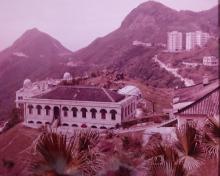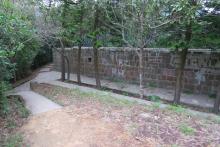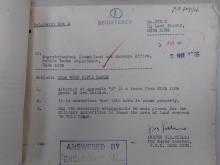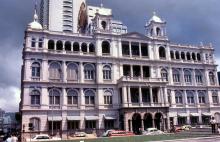Rifle range on the Peak: The Butts [????- ]
Primary tabs
Martin Booth mentions this range a couple of times, as part of his walk along Harlech Road:
[...] passing a waterfall, and arriving at the place where the soldiers lay down to shoot across a valley at the butts.
You can still see the butts area today.
At the junction of Harlech & Lugard roads is a small cleared area with a pavilion and a few exercise stations. In the southern corner of that cleared area is a path that leads off through the bushes. If you follow the path you'll reach the old butts area.
The path passes a non-descript concrete hut on the right, then on the left is a stone wall, with an earth bank on the other side. I believe this is where the targets were set up. The people managing the targets would be safely down behind the wall.
The path carries on to a small clearing - I think this was the butts area, where the bullets would land after passing through the targets
The path continues from there up to the top of High West. It's a steep climb, but there are great views from the top.





Comments
The Butts
Hi there,
I went there again earlier today. When you are there, you are unable to see the line of sight as there are trees. So I went up the path to the Peak of the High West and took this photo:
The line of sight clearly go towards the cut-away slopes Mr B mentioned.
Some more photos:
Pay attention to the bullet holes near the roof.
A stone wall at the butts.
The top/front side of the butts. The stone wall was right under the fence.
Some sort of a bunker, the same one with bullet holes shown above.
The path leading from Harlech Road.
Best Regards,
T
Those bullet holes
T, thanks for the extra info & photos. I hadn't spotted the bullet marks on the top of the concrete building. As I remember it's off to the side of the butts, so it doesn't say a lot for their marksmanship!
As a teenager, one summer we went to Army Cadet camp, where one of the activities was to go out to the rifle range. They were heavy old bolt action rifles (.303 still, I think), and it was much as I could do to lift them up, let alone aim them.
Down at the butts there was someone assigned to each target. If you hit it, they had an arrow on a long stick they'd point up to show where your bullet went through. I forget how many shots we were allowed, but whoever was sitting under my target didn't have to get out of his chair!
MrB
Peak Rifle Range
Does anyone know any more history on this place? Such as when it was opened/closed and who mainly used it?
Cheers.
re: Peak Rifle Range
I've just put up a new place for Mount Austin Barracks, which were used by the British army from 1897 til 1941. I'd think soldiers stationed at those barracks would have been the most likely people to use the range.
Does anyone else know the history of the range? Was it used by the Japanese during their occupation of HK? How long was it used after 1945, and by whom?
Any luck finding anything there with your metal detector?
Re: Peak Rifle Range
1906 PWD Annual Report
At the request of the Volunteer Reserve Association (Hong Kong Volunteer Corps), a new rifle range was constructed at the Peak. The butts are situated on the eastern slope of High West and the firing points below the Harlech Road, at ranges 200, 300 400 and 500 yards. The targets which were obtained from England, are of Jeffries' Patent 'Wimbledon' type and a small building has been constructed for them when not in use. The range was finally handed over to the Association in October.'
In later years rifle practice was conducted once a week at the range.
THE BUTTS
As a kid in the 70's I spent hours and hours picking up bullets clips from around this area. My father mentioned that also the police used the range and that he also used it so that would have been in the early 50's. I spent many hours running around the hills of Hong Kong and would be keen to revisit some of the best tunnels i found as a kid. In particular a complex set of Japanese tunnels half way up Wong Nei Chung gap. Anyone keen to try and find these please let me know. Always wanted to find them again as they were very extensive and I don't think many people have located them.
Re: The Butts, new photo from atop
Hi there,
I took thos photo from higher up last Sunday:
Best Regards,
T
Japanese bullets at High West rifle range
Hello! Today, having a whole bunch of nothing to do, I headed up to the Butts for a quick scan with my metal detector.
In one short hour, I've found 8 .455 Webley bullets, 3 Mk. VII .303 bullets, 3 Mk. VI .303 bullets, 5 bits of bullet fragments (one of them probably being the ogive of a Mk. VII), and one rusted bullet which might be a Mk VII.
Additionally, I found a bullet which was of a smaller caliber than the .303s I found. It is likely to be a Japanese 6.5 mm bullet from a Type 38 bolt-action rifle. It had a weight (132.5 gr measured vs. 138 gr actual), length (33mm measured vs. 32.5mm actual) and diameter (7mm measured vs. 6.5mm actual) consistent with 6.5 mm Japanese. This leads me to highly suspect Japanese usage of this site for target shooting, as (to my knowledge) the Battle of Hong Kong did not progess far enough west for this site to see combat. Further searching is needed to establish the frequency of usage of this site by the Japanese. Is this a one-off thing by a bored Japanese soldier? Or was there systematic, regular training at this site?
I also found one 9mm pistol shell casing at the site. I had found 2 on an earlier, naked-eye-only hunt of the site. The one I found today is headstamped:
[unintelligible]ᗑN 44
[unintelligible]MM IIZ
This is consistent with British military 9mm ammunition manufactured at the Royal Ordnance Factory at Hirwaun, South Wales. This shows that the site was used, likely by the military, post-war (possibly recently post-war).
Additionally, the fact that these shell casings were found also suggests that the site may have been used as the firing point of a short-range pistol/SMG shooting range, in addition to being the target end of a longer rifle range. However, 9mm bullets were not found, possibly suggesting that they were firing from the site towards a different target area. More searching is needed.
butts
I also roamed around Harlech road and the Butts in the mid 1960's. Would often then climb High West, no concrete steps in those days!
Then would follow an overgrown dry stream bed down to a place we called Belchers Fort.Continuing dwn a pathe of sorts we came out at a large nullah entrance that had iron bars across it. I think this might have led to Lyllaton Rd near HKU!
Returned in 1997 and made it to the top of High West again, aged 50 and the view was as magical as when
I was a kid!